Scrap Prices North America

Higher Scrap Pricing Forecast for January
Written by John Packard
December 10, 2013
The U.S. ferrous scrap market has seen prices moving higher during the first 10 days of December. We have seen shredded scrap prices moving $20 to $45 per gross ton depending on the market. Busheling has been more plentiful and has managed to remain stable to up $10 in most markets.
We asked one of our sources out of the East Coast to provide some color as to how they are seeing not only the current market, but where prices will go from here and what impact will Nucor’s DRI project have on market prices.
“The market arguably has not settled because it is continuing to move up and there is very limited scrap availability. And, depending on when dealers sold in December, they got progressively better prices.
Shred traded anywhere from $380-$405. It should be even higher than that, and it is almost anywhere in the country you look. HMS traded anywhere from $340-$355. P&S, which there happens to be a good bit of, is in the $370 range. Busheling, which is never strong in the east is $395-$400.
This is a very constrained market in the context of one with slightly improving demand and mill lead times. It has been for several months and flows have not really started to improve yet. There is only one direction for the market now, and the only question is how much higher will the scrap market climb to satisfy demand come January.
There are a number of forces converging to perhaps make January much stronger even after two call them $30 increases in November and December. Besides being in a generally very supply constrained market, mills are going to drive inventories down at year end. Some will more than others but on the whole that is what they do.
Demand seems to be improving – as you note more and more annual contracts are being put in place. If export volumes pick up which would drag price higher too, look out. I think I have said that before recently, but I believe it more now than I did the last time I said it.
The near-term impact of Nucor DRI is as much psychological as anything else. Realistically, the plant is probably not coming on line in the next two weeks. Even if it does, there will still be a real need for prime scrap. This could go on for several months.
There is the presence of pig iron which will keep a lid on scrap prices but if pig producers know they can take the market higher they will. Eventually, there will be a real impact of the DRI supply, but I don’t think its going to be acute if the finished market continues to improve. If demand falls off, that is a different story. Watch what the mills do with respect to their prime scrap needs, not what they say.

John Packard
Read more from John PackardLatest in Scrap Prices North America

HRC vs. scrap spread widens over $150/ton in March
The HRC vs. prime scrap spread increased again in March.

HRC vs. prime scrap spread increases in February
The price spread between hot-rolled coil (HRC) and prime scrap widened in February ahead of the implementation of President Trump’s tariffs on steel.
HRC vs. prime scrap spread narrows again in January
The price spread between hot-rolled coil (HRC) and prime scrap continued to narrow in January, according to SMU’s most recent pricing data. While SMU’s average HRC price edged down week over week (w/w), it rose compared to a month ago. The January price for busheling also increased from December. Our average HRC price as of […]

HRC vs. prime scrap spread flat in November
The price spread between hot-rolled coil (HRC) and prime scrap remained the same in November as both tags were at the levels seen a month earlier, according to SMU’s most recent pricing data.

HRC vs. busheling spread narrows slightly in October
The price spread between hot-rolled coil (HRC) and prime scrap narrowed marginally in October, according to SMU’s most recent pricing data.
